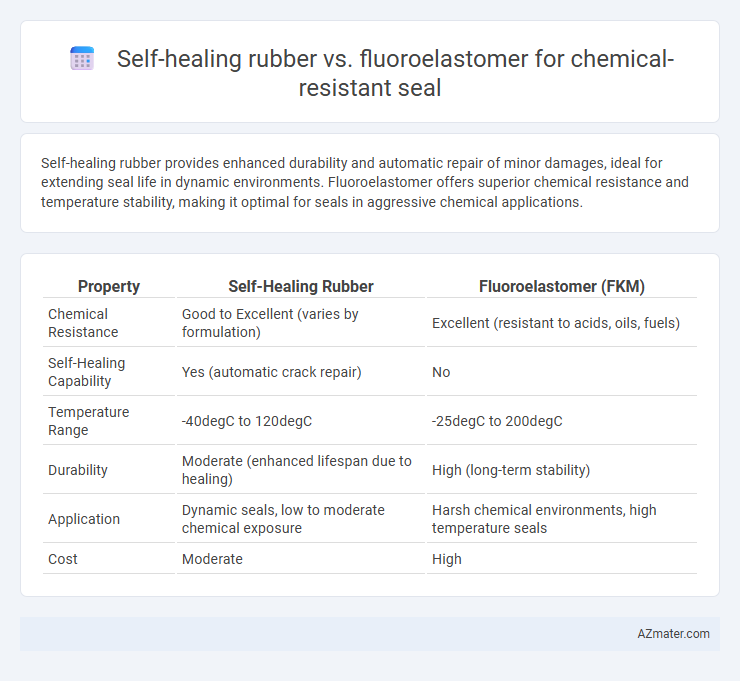Self-healing rubber provides enhanced durability and automatic repair of minor damages, ideal for extending seal life in dynamic environments. Fluoroelastomer offers superior chemical resistance and temperature stability, making it optimal for seals in aggressive chemical applications.
Table of Comparison
| Property | Self-Healing Rubber | Fluoroelastomer (FKM) |
|---|---|---|
| Chemical Resistance | Good to Excellent (varies by formulation) | Excellent (resistant to acids, oils, fuels) |
| Self-Healing Capability | Yes (automatic crack repair) | No |
| Temperature Range | -40degC to 120degC | -25degC to 200degC |
| Durability | Moderate (enhanced lifespan due to healing) | High (long-term stability) |
| Application | Dynamic seals, low to moderate chemical exposure | Harsh chemical environments, high temperature seals |
| Cost | Moderate | High |
Introduction to Chemical Resistant Seals
Chemical resistant seals require materials with exceptional durability and resistance to aggressive chemicals, making self-healing rubber and fluoroelastomers prime candidates. Self-healing rubber offers innovative damage repair capabilities, enhancing seal longevity and preventing leakage in chemically harsh environments. Fluoroelastomers provide superior chemical resistance to acids, fuels, and solvents, maintaining integrity under extreme temperatures and pressure conditions.
Overview of Self-Healing Rubber
Self-healing rubber is an innovative material designed to automatically repair micro-cracks and damages, significantly extending the lifespan of chemical-resistant seals. Unlike fluoroelastomers, which rely on their inherent chemical inertness and thermal stability, self-healing rubber leverages dynamic bonding mechanisms that enable the material to restore its integrity under exposure to harsh chemical environments. This advancement reduces maintenance costs and downtime in industrial applications requiring durable sealing solutions against aggressive chemicals.
Properties of Fluoroelastomers
Fluoroelastomers exhibit exceptional chemical resistance, maintaining stability against aggressive solvents, oils, and fuels at temperatures up to 200degC. Their molecular structure provides superior resistance to swelling, deformation, and degradation in harsh chemical environments, making them ideal for seals in demanding industrial applications. Unlike self-healing rubbers, fluoroelastomers deliver long-term performance and durability under continuous exposure to corrosive substances.
Chemical Resistance Comparison
Self-healing rubber exhibits moderate chemical resistance, effectively recovering from minor damages caused by acids, bases, and solvents, making it suitable for dynamic sealing applications where durability is crucial. Fluoroelastomers, such as Viton, offer superior chemical resistance against a broad spectrum of aggressive chemicals including fuels, oils, and strong acids, maintaining integrity under high-temperature conditions. In chemical-resistant seal applications, fluoroelastomers outperform self-healing rubbers by providing enhanced longevity and stability in harsh chemical environments.
Mechanical Performance and Durability
Self-healing rubber exhibits enhanced mechanical performance through its ability to autonomously repair micro-cracks, extending the seal's lifespan under cyclic stresses and reducing downtime. Fluoroelastomers offer superior chemical resistance, maintaining structural integrity and elasticity in aggressive environments such as exposure to fuels, oils, and solvents, thereby ensuring long-term durability. Comparing both, self-healing rubbers excel in resilience to mechanical fatigue while fluoroelastomers provide unmatched chemical stability in high-temperature, corrosive applications.
Self-Healing Mechanisms in Rubber
Self-healing rubber utilizes microcapsules or reversible cross-linking networks that autonomously repair damage by releasing healing agents or reforming chemical bonds, enhancing durability in chemical resistant seals. Fluoroelastomers, although highly resistant to harsh chemicals due to their fluorinated polymer backbone, lack intrinsic self-repair capabilities and rely solely on their inherent material stability. The self-healing mechanisms in rubber improve seal longevity and performance by reducing cracks and leaks under chemical exposure, making them advantageous in dynamic sealing applications.
Temperature and Environmental Stability
Self-healing rubber offers moderate temperature resistance, typically up to 100degC, with excellent environmental stability due to its ability to autonomously repair micro-damages, enhancing durability in dynamic chemical environments. Fluoroelastomers provide superior chemical resistance and high-temperature stability, maintaining performance in extreme conditions up to 200degC or higher, with exceptional resistance to oils, fuels, and aggressive chemicals. For chemical-resistant seals, fluoroelastomers are preferred in high-temperature applications, while self-healing rubber excels in environments requiring self-repair and moderate thermal stability.
Industrial Applications and Suitability
Self-healing rubber demonstrates superior adaptability in industrial applications requiring extended service life and minimal downtime due to its intrinsic ability to recover from surface damages, making it ideal for dynamic sealing environments exposed to mild chemicals. Fluoroelastomers excel in chemical resistance, particularly against aggressive fluids like hydrocarbons, acids, and solvents, offering exceptional thermal stability and durability in harsh industrial conditions such as chemical processing and oil refining. Selecting between self-healing rubber and fluoroelastomer hinges on the specific chemical exposure, temperature ranges, and mechanical stresses of the application, with fluoroelastomer favored for aggressive chemical resistance and self-healing rubber preferred where maintenance reduction is critical.
Cost and Availability Analysis
Self-healing rubber offers a cost-effective solution with moderate availability, making it suitable for applications requiring repairable seals with resistance to common chemicals. Fluoroelastomers exhibit superior chemical resistance and durability but come at a significantly higher price point and limited supplier availability, impacting project budgets and timelines. Evaluating cost-benefit trade-offs and supply chain stability is crucial when selecting between these materials for chemical-resistant seals.
Future Trends in Chemical Resistant Sealing Materials
Self-healing rubber offers innovative advantages in chemical resistant seals by autonomously repairing micro-damages, significantly extending service life and reducing maintenance costs in aggressive chemical environments. Fluoroelastomers maintain critical market dominance due to their exceptional resistance to high temperatures, aggressive chemicals, and oxidative degradation, making them indispensable in extreme sealing applications. Future trends indicate a convergence where self-healing capabilities are integrated with fluoroelastomer matrices, leveraging nanotechnology and advanced polymer blends to create next-generation seals with superior durability, environmental resistance, and operational efficiency.

Infographic: Self-healing rubber vs Fluoroelastomer for Chemical resistant seal
 azmater.com
azmater.com